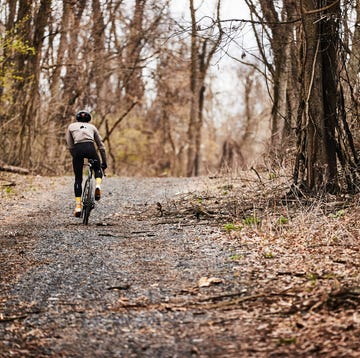In Steamboat Springs, Colorado, winter hits hard: Getting over the nearby mountain pass to get into town becomes nearly impossible for trucks, and cars are banned from making the trek without chains.
But nestled in the little ski town is the Moots factory, and the people there who help build the company’s titanium bikes are avid cyclists, even in negative temperatures. Snow, wind, rain, salt and slush are all par for the course in this town, and Nate Bradley, Moots’s company president, shares a few of his best tips for surviving bad weather on your bike.
Winter Bike Maintenance Essentials
Cleaning your bike regularly in good weather is one thing, but once temperatures drop and the weather gets bad—the time we need to clean our bikes the most—it becomes a Herculean task.
Bradley says his number one tip is preventative action: Create a good bike-washing setup before bad weather strikes so you’re ready. He swears by a cheap pump-action garden sprayer for cleaning off his bike in the garage (with a drain nearby), which can also be done in the driveway post-ride. He also heads to Home Depot for cleaning brushes, and loves grout-cleaning brushes and refrigerator-coil brushes for tight spots.
Your goal here is to get that grime out of moving parts and off your bike’s frame as soon as possible: Don’t let it collect.
Bradley uses cooking sprays (yes, cooking sprays!) like Pam as undercoats for cleats and his metal frame, which make wiping off grime easier. It also gives the bike a bit of a buffer from the elements. (Just don’t get it on disc brakes or wheel rims for cantilever bikes.)
He also recommends a silicone spray on pedals, or for really brutal conditions, he’ll use DuPont’s snow and ice repellent made for snowblowers on his cassette and downtube.
Regularly lubing your chain also becomes more important in bad weather. In normal rain and mild snow, use your favorite bike lube to keep your chain running smooth and quietly.
Keeping your bar tape and saddle dry will make them last longer, which presents problems in bad weather. Saddles are especially at risk when you ride with rain pants. “That’s the worst thing you can do,” says Bradley. “All the grit and water gets on your pants and they rub around on the saddle.”
Mitigate these issues by cleaning your saddle and bar tape as soon as possible, getting that salt and grime off fast.
Choose the Right Fenders and Tires for Winter Riding
In really bad weather, studded tires are great, but there are plenty of softer rubber-compound tires with winter treads.
Bradley’s top picks are cyclocross file-tread tires. “They usually have nice rubber, and nice casings, and they work great in deep winter,” he says. The file tread is ideal because the treads on the sides offer traction in bad conditions, but the main tread rolls almost as smooth as road tires.
Even more important than tread, Bradley says, is choosing the right tire pressure. If you can, run your pressure on the lower end of what you’re comfortable with, he says: “You want the tire to move around and conform to grip the frozen surfaces.”
Just as important as selecting the right tire is selecting the right kind of fenders for riding in the snowy and slushy conditions.
“Full-coverage fenders are great when it rains, but once it’s frozen, they’ll fail,” says Bradley. “They’re the worst thing you could use, because they end up working as full coverage tire brakes.”
Because of that, Bradley uses a clip-on fender for snowy weather instead, since it’s easier to move and empty once it’s jammed with snow.

Molly writes about cycling, nutrition and training with an emphasis on bringing more women into sport. She's the author of nine books including the Shred Girls series and is the founder of Strong Girl Publishing. She co-hosts The Consummate Athlete Podcast and spends most of her free time biking and running on trails, occasionally joined by her mini-dachshund.













